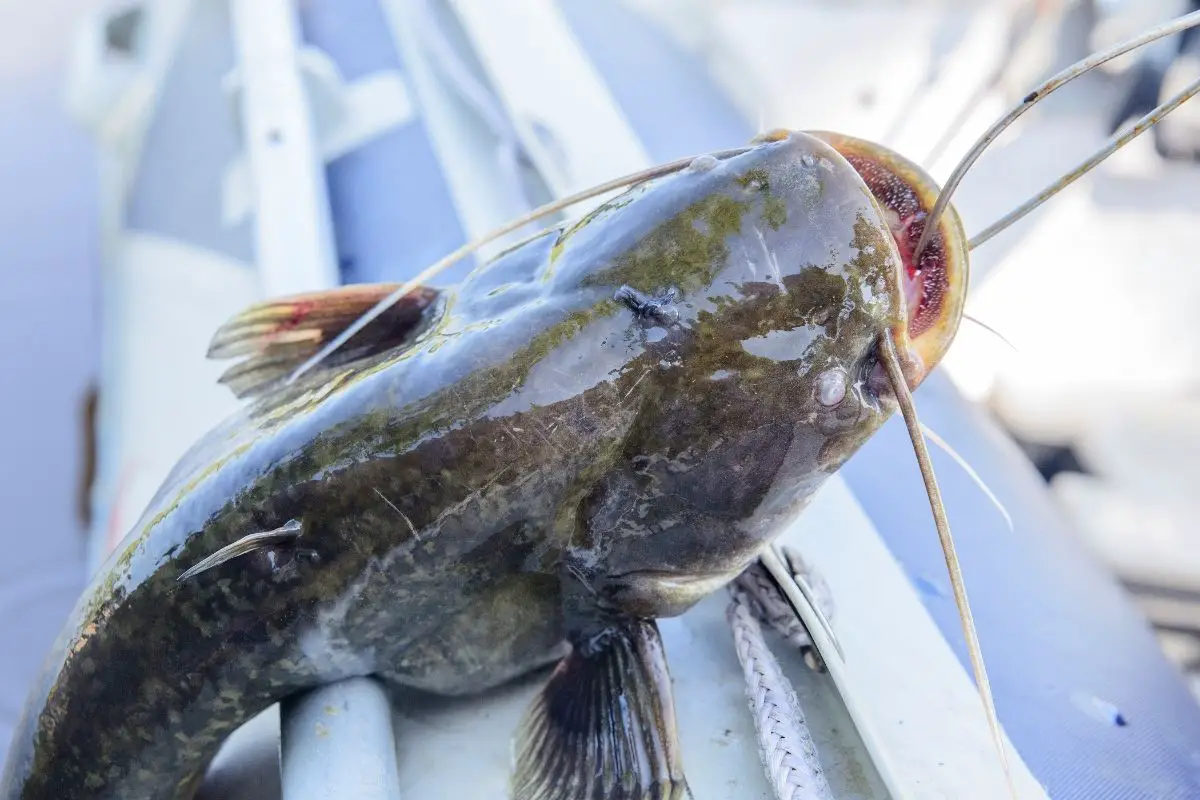Catfish are a popular fish that anglers fish for because they are fun, challenging, and tasty.
Catfish are interesting-looking fish that look great in photos but are you at risk of being stung by one and how to hold a catfish do to prevent it from happening
In this guide we will go into more detail about how to hold a catfish are, do they sting, how to hold one correctly, and what to do if you get injured by one.
This allows you to be prepared for the next time that you go fishing for catfish, knowing that it won’t end up in an injury.
What Is A Catfish?
The name catfish is given to a diverse group of ray-finned fish that were given the name due to their barbels that look similar to the whiskers on a cat.
Even though catfish can come in a range of different colors and sizes, there are three main types known as blue catfish, channel catfish, and flathead catfish.
Most catfish species are negatively buoyant which makes them predominantly bottom feeders and their flat head allows them to dig up dirt and foliage to reveal whatever food is hiding beneath it as catfish are not picky and will eat almost anything.
Catfish are usually found in muddy lakes, rivers, and along the coasts of tropical or subtropical bodies of water. Depending on what type of catfish it is, they can be found in both fresh water and saltwater.
The barbels on either side of the catfish’s mouth have cells coated all over them which give them the ability to taste their food. Catfish species such as the channel catfish have four pairs of barbels that are positioned around their mouth and chin.
Catfish lack scales, and their bodies are frequently bare other than the mucus-covered skin of some species which they can use to breathe through in some catfish species.
Other types of catfish can have skin that is coated in bony plates instead called scutes which acts as armor, protecting the catfish.
Do Hold A Catfish?
Catfish are typically not aggressive and most injuries that are caused by them are when humans step on them or are holding them, and they thrash around.
There is a common myth that the barbels on a catfish are dangerous as they use them to sting you, but this is not true as these barbels are harmless and are there to sense and taste food.
However, catfish can sting you using a whole different part of their body that you may not be aware of which are the dorsal and pectoral fins that most catfish have.
These spines can be locked into place as a defense, causing them to stick outwards and inflict serious wounds.
Especially if a catfish is irritated, these fin rays can be employed to deliver a stinging protein by a venom that is created by the glandular cells in the covering of the spines.
Depending on the type of catfish, this protein is so potent that it can put humans in the hospital if they are stung and can sometimes be fatal if they are not given medical attention soon enough.
However, with most freshwater catfish found in North America, the stings are uncomfortable and somewhat painful but are not unbearable but if your wound is open and gets infected then that is where it can become serious.
It may be surprising, but you will need to be more careful with younger catfish as their spines and fins are much sharper and small like needles which make them very easy to sink into your skin when they thrash around in your hands.
If you do get impaled by the spine of a young catfish, they can be quite difficult to remove and can even pierce through the sole of a shoe, but over time they will dull as the catfish gets older and this won’t be as much of a risk.
It is a general rule that smaller catfish that you find in saltwater are more notorious for stinging you than the ones that are found in freshwater which grow to be bigger with some able to reach 100 pounds.
What To Do If You Are Stung By A Catfish

Tyger Leader is reader-supported and may earn a commission when you book or purchase using our links. Learn more about our affiliate disclaimer here.
Catfish can be quick, especially the small ones, and sometimes you aren’t quite fast enough to get your hand out of the way, and you end up getting stung.
The severity of this injury depends on how deep it is, where you were stung, and how clean the wound is. Also, keep in mind that certain underlying health conditions can make the effects of the sting more serious.
If you are out on a boat and are stung by a catfish, the first thing you need to do is get back to shore as quickly as possible as a sting can make you feel lightheaded and nauseous – making water a very unsafe place to be.
You may feel the urge to put some ice on the wound to help with the burning, but this will only make things worse as the cold will make the toxins more powerful and will leave you in more pain than you began with.
Instead, you must immerse the wound in very hot water but not too hot that you scald yourself as it will help reduce the pain. Water that is hotter than 122 °F is the temperature that is recommended by researchers and within half an hour you should feel the pain start to subside.
Keep an eye on the injury and if you notice any redness, swelling, or tenderness you must seek medical attention as soon as you can.
If the wound is infected, you will likely be prescribed antibiotics and if there is any debris stuck inside the injury, they will remove it.
How To Hold A Catfish?
Certain species of catfish can be quite hard to hold due to their slimy skin, this means you have to take more care with how you hold them as one wrong move could result in a spine sticking into your skin.
To hold a catfish safely, you will need to have a firm grip on it with the dorsal fin pressed flat and the pectoral fins well out of the way of your hands.
If the catfish is quite small, you may be able to hold them in just one hand with the catfish gripped in front of its dorsal fin and behind the two pectoral fins.
When it is time to release a small catfish, the best way to do it is by dropping them out of your hand and straight into the water so that they lost contact with your hand as soon as they can move.
This is why you should not try to throw a catfish into the water because the movement can drive the fins into your hand.
To be extra safe, you can buy a pair of gloves that have been specially made for handling catfish, but you should note that your hands won’t be as sensitive to what they are holding.
Summary
To summarize, yes catfish can sting you, but it is not with their barbels contrary to popular belief. Instead, it is the dorsal and pectoral fins that you need to watch out for, especially in the smaller catfish as they are much sharper and easy to get stuck inside your skin.
Do not let this put you off though as most of the time the pain is not too bad especially if you have been stung by a freshwater catfish, but you should still seek medical attention if you notice redness, swelling, and tenderness.
Clean the wound by immersing it in hot water straight away to get rid of any extra debris to prevent infection and get to shore where you are most safe.
With all of that in mind, do not let it put you off of fishing for catfish because if you take the proper precautions with gloves and correct handling, you will greatly reduce the risk of getting stung, and you can have peace of mind as you pose with them.



